
Welcome to tampaflsnakes.com! I am David, a snake enthusiast living in Tampa, FL. Many people don't know that Tampa is in fact full of snakes! You just need to know where to find them - they can often be shy and elusive. Some Florida snake species are more common outside of the city limits, in different parts of Hillsborough County FL, but many types of snakes are indeed common in the more urban parts of Tampa. This guide is meant to help educate you about the beautiful snakes of Tampa, and to help you identify the most common snakes of Tampa, as well as the venomous snakes of Tampa that you should learn to recognize and avoid. If you want more detail, click here for my complete list of ALL snake species in Tampa. Remember the following:
- Most snakes of Tampa are harmless and don't want to encounter you
- Venomous snakes exist but are uncommon in Tampa, Florida
- Snakes eat rats and mice and are a valuable part of the Florida ecosystem
- Never kill a snake - if you leave a snake alone, it will leave you alone.
Common Snake Species in Tampa
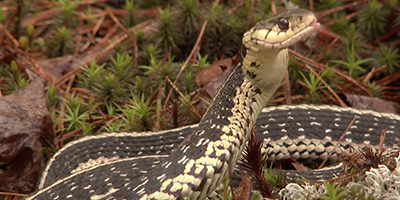 Common Gartersnake:
The common gartersnake is usually brown-black in color. Their bodies are also marked with three yellow stripes that are sometimes absent or are very faint. They also have stripes on their sides that can range from blue-white. Each of their sides is marked with a checkerboard-like pattern that may sometimes cover the stripes they have. These snakes are also sometimes mistaken as the pygmy rattlesnake but tend to be thinner and have round eye pupils. This snake also gives birth rather than lay eggs.
Common Gartersnake:
The common gartersnake is usually brown-black in color. Their bodies are also marked with three yellow stripes that are sometimes absent or are very faint. They also have stripes on their sides that can range from blue-white. Each of their sides is marked with a checkerboard-like pattern that may sometimes cover the stripes they have. These snakes are also sometimes mistaken as the pygmy rattlesnake but tend to be thinner and have round eye pupils. This snake also gives birth rather than lay eggs.
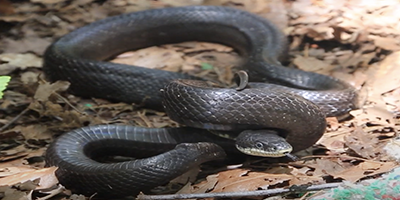 Eastern, Yellow, or Everglades Rat Snake:
Eastern rat snakes have blotches around their bodies that slowly fade away once they enter adulthood. As young adults, they usually have a light to dark gray color. Their backs are usually marked with gray-black blotches, which also fade away as they age. The bodies of adults tend to be either yellow or yellow with a hint of gray, their backs are marked with four dark stripes, which can occasionally have blotches. There are certain places where these snakes tend to have an orange to brown color and lack or have a fading stripe. This snake is also known to lay eggs. The eastern rat snake can grow up to 5.5 feet but can reach up to 7.5 feet in special cases.
Eastern, Yellow, or Everglades Rat Snake:
Eastern rat snakes have blotches around their bodies that slowly fade away once they enter adulthood. As young adults, they usually have a light to dark gray color. Their backs are usually marked with gray-black blotches, which also fade away as they age. The bodies of adults tend to be either yellow or yellow with a hint of gray, their backs are marked with four dark stripes, which can occasionally have blotches. There are certain places where these snakes tend to have an orange to brown color and lack or have a fading stripe. This snake is also known to lay eggs. The eastern rat snake can grow up to 5.5 feet but can reach up to 7.5 feet in special cases.
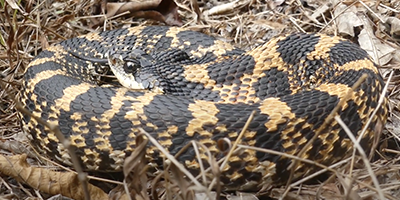 Eastern Hog-nosed Snake:
The eastern hog-nosed snake can range from gray, yellow, brown, or even black. The undersides of their tail tend to be lighter than their bellies. Their backs and sides are also marked with dark-brown blotches. Their necks are also marked with large blotches, and their foreheads are marked with a dark band that reaches to the back of their eyes, all the way to the corners of their jaws. This snake is nicknamed the “spreading adder” due to the fact that when it plays dead it flattens its neck and hisses. The eastern hog-nosed snake can reach up to 3.5 feet, but are usually around the range of 1.5-2.5 feet.
Eastern Hog-nosed Snake:
The eastern hog-nosed snake can range from gray, yellow, brown, or even black. The undersides of their tail tend to be lighter than their bellies. Their backs and sides are also marked with dark-brown blotches. Their necks are also marked with large blotches, and their foreheads are marked with a dark band that reaches to the back of their eyes, all the way to the corners of their jaws. This snake is nicknamed the “spreading adder” due to the fact that when it plays dead it flattens its neck and hisses. The eastern hog-nosed snake can reach up to 3.5 feet, but are usually around the range of 1.5-2.5 feet.
Venomous Snake Species in Tampa
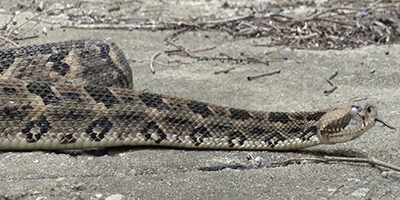 Timber Rattler:
The timber rattler has a tendency to stay in woodpiles along with diamondback snakes. This snake is immensely dangerous due to its lethal poison and as such, it should be avoided at all costs. They make it easy for themselves to be detected however for they rattle their tails before they strike.
Timber Rattler:
The timber rattler has a tendency to stay in woodpiles along with diamondback snakes. This snake is immensely dangerous due to its lethal poison and as such, it should be avoided at all costs. They make it easy for themselves to be detected however for they rattle their tails before they strike.
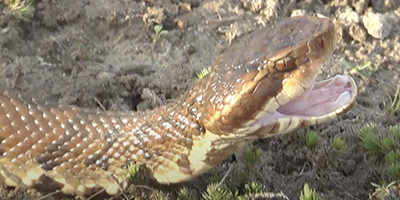 Cottonmouth/Water Moccasin:
Cottonmouth snakes are one of the most feared snakes in Tampa. These snakes have large mouths paired with long and venomous fangs. They also have a tendency to strike without warning due to their short tempers. These snakes tend to slither into pools and other places with water. Which makes it a point to canvas the area. When you come across this snake be sure to steer clear and call for pest control if they haven’t been called yet.
Cottonmouth/Water Moccasin:
Cottonmouth snakes are one of the most feared snakes in Tampa. These snakes have large mouths paired with long and venomous fangs. They also have a tendency to strike without warning due to their short tempers. These snakes tend to slither into pools and other places with water. Which makes it a point to canvas the area. When you come across this snake be sure to steer clear and call for pest control if they haven’t been called yet.
If you're unsure, you can email me a photo of the snake at info@tampaflsnakes.com and I will email you back with the snake's species. If you found a snake skin, read my Found a Skin? page, and you can email me a photo of the skin, and I'll identify the snake for you. If you need professional Tampa snake removal help, click my Get Help page, or see the below website sponsor I found, who provides that service.
Red-Tailed Boa In Florida
Although Florida is a wonderful state that has a temperate climate and some wonderful water areas, it isn’t just people who think this way, as there are some non-native species of snakes that have become established in the state. One such snake is the Boa constrictor, or more specifically the Red-Tailed Boa (Boa Constrictor Constrictor), which has established a significant population in the area round Miami. It is believed that this occurred because of an illegal release of pet snakes, which has now become a significant problem in some parts of the state.
Appearance And Diet
The Red-Tailed Boa is a large snake that can grow anywhere from three to thirteen feet in length, and are also heavy bodied meaning they can often weigh in excess of fifty pounds. The body of the Red-Tailed Boa is generally a light brown or khaki color, with dark brown bands appearing down the body, but it is the thicker bands towards the end of the tail which have some red coloring along with the dark brown that give the snake its name. The head is generally in proportion with that end of the body, and will usually have a dark line running down the centre of the head.
The Red-Tailed Boa is part of a larger family of constrictor snakes which will kill their prey before eating it through constriction, and in this area of South Florida there are plenty of small animals to eat. They will often eat mammals such as mice, rats and rabbits, but are also known to feed on birds, frogs and even other snakes where available. It is this ability to feed on many different species that are populous in Florida that has led this snake to becoming an established species in the area.
Behavior And Habitat
These snakes are generally nocturnal, and in the warm Florida climate they will very rarely need to bask during the day, as temperatures do not drop low enough during the night to necessitate this. The Red-Tailed Boa is an animal that should be avoided by humans if possible, and although they aren’t venomous, they can bite when threatened or disturbed, which can transmit infections.
In terms of the habitat of this particular constrictor in Florida, it is generally to be found in the pine rocklands and tropical hardwood areas, but it can survive in most forested areas. Younger Red-Tailed Boas can climb trees in order to look for prey, but as they become older and larger, they will generally stay on the ground. Although generally found in the area around Miami, there have been rarer sightings of the Red-Tailed Boa further north in Florida too.
Reproduction And Growth Cycle
Although the Red-Tailed Boa is generally a solitary animal, they will come together in order to mate, which will usually happen between April and August. Females will be able to mate from around three years old onwards, and during the mating season males can mate with a number of different females. Once the females and males have mated, gestation will not necessarily begin immediately, as the female can hold the sperm for a long time, but eventually a post-ovulation swell will become apparent.
Once begun, gestation will usually last between three and a half and four months before between twenty and fifty live snakes are born. These juvenile Red-Tailed Boas are born between fifteen and twenty inches in length, and will grow quickly for the first few years until they become sexually mature, when the cycle of growth and shedding their skin will slow down. These young snakes are independent from their birth, and will quickly become independent solitary snakes.
Remember, the term is not poisonous snakes of Tampa, it's venomous snakes of Tampa. Poison is generally something you eat, and venom is injected into you. That said, dangerous snakes are very rare in Tampa. The few venomous snakes of Hillsborough County are rarely seen. But they are commonly misidentified, so learn about all the snake species of Tampa in order to correctly identify them. These snakes are usually also found in the surrounding towns of Tampa, Plant City, Brandon, Riverview, Valrico, Ruskin, Temple Terrace, Seffner, Sun City Center, Wimauma, Gibsonton, Greater Carrollwood, Town 'n' Country, Thonotosassa, Westchase, Bloomingdale, Citrus Park, Dover, Greater Northdale, University, Lake Magdalene, Palm River-Clair Mel, Balm, Progress Village, Egypt Lake-Leto, East Lake-Orient Park, Keystone, Cheval, Pebble Creek, Mango and the surrounding areas.
Read our article about:
Does Rope Work As A Snake Repellent?
tampaflsnakes.com domain and hosting costs made possible by the generous support of this sponsor:
